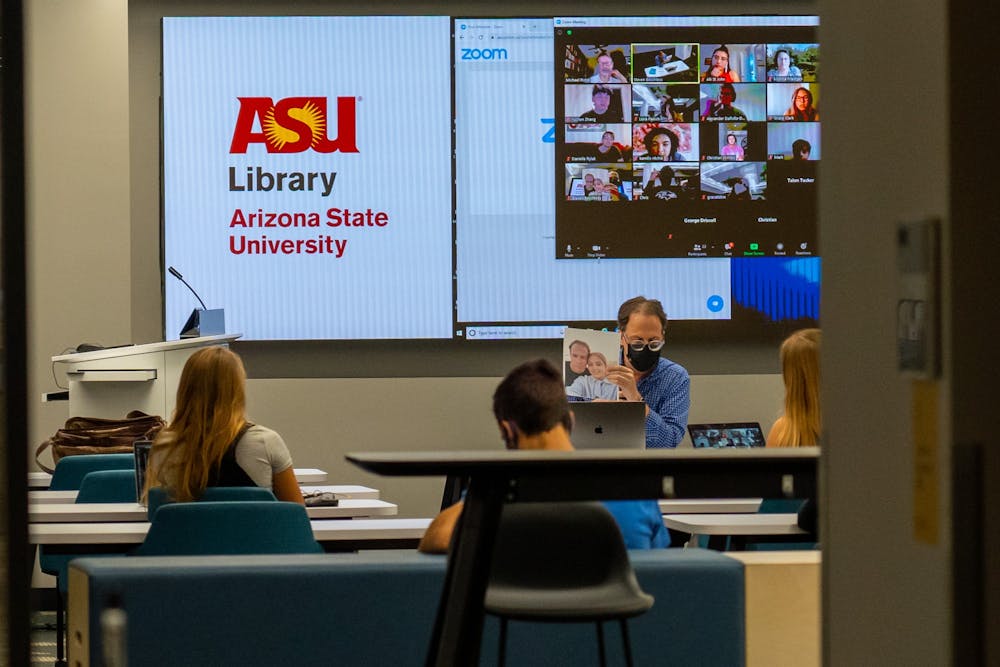Professors are learning alongside the students they teach that hybrid learning is no easy feat to conquer. Before the pandemic, many educators had never taught outside of a traditional classroom environment. Now that hybrid learning is the mode in which many ASU professors are teaching, they've had to adjust to the altered teacher-student dynamics.
ASU has switched to three separate learning modes, or modalities: fully online, in-person or ASU Sync — a blend of some in-person classes and some through Zoom. Through ASU Sync, professors juggle the needs of the students who attend physically and virtually. Students have the option to attend classes in person on designated days, or they can opt to learn through Zoom for all their classes.
READ MORE: Three types of ASU Sync classrooms available for various class needs
Some instructors, especially those who teach courses that rely on hands-on learning and strong connections between participants, said they felt a loss when instruction is all done through a screen.
“It’s a challenge,” economics clinical professor Daniel Marburger said. “We were in Zoom workshops over the summer, and it was hard for even me to focus, let alone for the students.”
Marburger said he values the connections he builds with his students in face-to-face settings and feels a heavy disconnect with the implementation of ASU Sync.
“Now I’m just a person on a T.V. to them,” Marburger said. “Especially with (economics), it was important that students felt like they could come up and ask me questions. Now I’m just some guy to them.”
Despite many ASU faculty members going remote for the semester through ASU Sync, there are some who choose to continue to operate in-person as long as their class sizes remain small and allow for social distancing.
Christopher LaMont, a clinical assistant professor at the New American Film School said his class sizes range from 10 to 40 people in his smallest and largest classes opting to learn in person.
"In all of my in-person classes, I have about 40% of my students coming into the classroom, so we're able to spread out," LaMont said.
Nita Blum, a faculty associate at the New American Film School, has taken a slightly different route than just keeping her courses available on Zoom and is instead opting for a few hybrid days scattered throughout the semester.
“In (intro to film production), the students are supposed to learn how to operate standard film equipment,” Blum said. “Most of that can be found at our studio, so once we get into those modules, I will have my class split off and come in on different days of the week.”
Blum said much of the hands-on experience and collaboration between classmates and instructors that are important to the class are strenuous when taught remotely.
“It’s definitely been hard to not be able to provide in-person feedback so far," Blum said. "This class is about building your network and finding the people you want to work with in the future too, so we’re trying to find a way to do that at a distance.”
For those who work in the arts, like Blum and LaMont, the pandemic brings with it a new layer of ideas for future projects.
“While my focus is teaching right now, this does come with a lot of room for creativity in the future,” Blum said. “We’re going through a time unlike any other, and for people in the industry and working in the other arts, there’s going to be so much interesting content that emerges from this.”
LaMont said he would rather be in the classroom with all his students, but there is no other way to conduct the "normal" academic world at this time.
"The administration is doing the best they can to make sure we all have options," LaMont said. "The goal is to make sure that the students are safe and learning effectively."
While he said it is difficult not working with his students in person, Marburger said the challenges also pose opportunities for growth.
“It’s a good challenge,” Marburger said. “The coronavirus is not anyone's fault, and as an educator, you always have to be willing to change it up, and this has been an interesting way to do that. It’s a learning curve.”
While many educators worry their students will not be as engaged with this new method of schooling, Samantha Zilmer, a senior studying electrical engineering, said students understand that for now, online and hybrid learning are the only viable options.
"All of my teachers are doing the best they can," Zilmer said. "There can be a lot of technical difficulties in order to get us all to see material over Zoom, but they're making it work."
Reach the reporter at skenoun@asu.edu or follow @thesabrinakeno on Twitter.
Like The State Press on Facebook and follow @statepress on Twitter.




